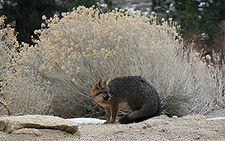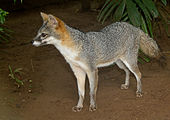- Gray fox
-
For other uses, see Gray fox (disambiguation).
Gray fox[1] 
Conservation status Scientific classification Kingdom: Animalia Phylum: Chordata Class: Mammalia Order: Carnivora Family: Canidae Genus: Urocyon Species: U. cinereoargenteus Binomial name Urocyon cinereoargenteus
(Schreber, 1775)Gray Fox range The gray fox (Urocyon cinereoargenteus) is a mammal of the order Carnivora ranging throughout most of[3] the southern half of North America from southern Canada to northern Venezuela and Colombia.[1][4] This species and the closely related Island Fox are the only living members of the genus Urocyon, which is considered to be among the most primitive of the living canids. Though it was once the most common fox in the east, and still is found there,[3][5][6] human advancement allowed the red fox to become more dominant. The Pacific States still have the gray fox as a dominant.
Contents
Origin
The gray fox appeared during the mid Pliocene epoch 3.6 million years ago (AEO) with the first fossil evidence found at the lower 111 Ranch site, Graham County, Arizona with contemporary mammals giant sloth, the elephant-like Cuvieronius, Large-headed llama, and the early small horses of Nannippus and Equus.[7]
Description and behavior
The gray fox is mainly distinguished from most other canids by its grizzled upper parts, strong neck and black-tipped tail, while the skull can be easily distinguished from all other North American canids by its widely separated temporal ridges that form a U-shape. There is little sexual dimorphism, save for the females being ever so slightly smaller than males. The gray fox ranges from 76 to 112.5 cm (30 to 44.3 in) in total length. The tail measures 27.5 to 44.3 cm (10.8 to 17.4 in) of that length and its hind feet measure 100 to 150 mm (3.9 to 5.9 in). It weighs 3.6 to 7 kg (7.9 to 15 lb).[4][8] It is readily differentiated from the red fox by the lack of "black stockings" that stand out on the latter.
The gray fox's ability to climb trees is shared only with the Asian raccoon dog among canids. Its strong, hooked claws allow it to scramble up trees to escape many predators such as the domestic dog or the coyote,[9] or to reach tree-bound or arboreal food sources. It descends primarily by jumping from branch to branch, or by descending slowly backwards as a house cat would do. The gray fox is nocturnal or crepuscular and dens in hollow trees, stumps or appropriated burrows during the day.
Reproduction
The gray fox is monogamous. The breeding season of the gray fox varies geographically; in Michigan, the gray fox mates in early March, in Alabama, breeding peaks occur in February.[4] The gestation period lasts approximately 53 days. Litter size ranges from 1 to 7. Kits begin to hunt with their parents at the age of 3 months. By the time they are 4 months old, the kits will have developed their permanent dentition and can now easily forage on their own. The family group still remains together until autumn when the young reach sexual maturity and then disperse.
Diet
The gray fox is a solitary hunter and is largely omnivorous. It frequently preys upon the Eastern Cottontail (Sylvilagus floridanus), though it will readily catch voles, shrews, and birds. The gray fox supplements its diet with whatever fruits are readily available and generally eats more vegetable matter than does the Red Fox (Vulpes vulpes).[4]
Subspecies
There are 16 subspecies recognized for this fox:[1]
- Urocyon cinereoargenteus cinereoargenteus
- Urocyon cinereoargenteus borealis
- Urocyon cinereoargenteus californicus
- Urocyon cinereoargenteus costaricensis
- Urocyon cinereoargenteus floridanus
- Urocyon cinereoargenteus fraterculus
- Urocyon cinereoargenteus furvus
- Urocyon cinereoargenteus guatemalae
- Urocyon cinereoargenteus madrensis
- Urocyon cinereoargenteus nigrirostris
- Urocyon cinereoargenteus ocythous
- Urocyon cinereoargenteus orinomus
- Urocyon cinereoargenteus peninsularis
- Urocyon cinereoargenteus scottii
- Urocyon cinereoargenteus townsendi
- Urocyon cinereoargenteus venezuelae
See also
- Urocyon progressus, also known as the Progressive gray fox.
References
- ^ a b c Wozencraft, W. Christopher (16 November 2005). "Order Carnivora (pp. 532-628)". In Wilson, Don E., and Reeder, DeeAnn M., eds. Mammal Species of the World: A Taxonomic and Geographic Reference (3rd ed.). Baltimore: Johns Hopkins University Press, 2 vols. (2142 pp.). ISBN 978-0-8018-8221-0. OCLC 62265494. http://www.bucknell.edu/msw3/browse.asp?id=14000841.
- ^ Cypher et al. (2008). Urocyon cinereoargenteus. In: IUCN 2008. IUCN Red List of Threatened Species. Downloaded on 06 May 2008. Database entry includes justification for why this species is of least concern
- ^ a b Maine Trappers Association fur auctions. Mta.homestead.com (2005-12-17). Retrieved on 2011-09-15.
- ^ a b c d "Urocyon cinereoargenteus". Animal Diversity Web. http://animaldiversity.ummz.umich.edu/site/accounts/information/Urocyon_cinereoargenteus.html. Retrieved 2007-08-19.
- ^ "Sometimes confused with the red fox because of cinnamon-red fur on its sides, the gray fox is increasingly common in rich hardwood forests of the northeast.". Hikenewengland.com. Retrieved on 2011-09-15.
- ^ "Gray fox are widespread in Connecticut.". Wildlifeofct.com. Retrieved on 2011-09-15.
- ^ Paleobiology database, Collection 19656, Graham County, Arizona. Authority by the Dr. John Alroy, February 18, 1993.
- ^ Boitani, Luigi, Simon & Schuster's Guide to Mammals. Simon & Schuster/Touchstone Books (1984), ISBN 978-0671428051
- ^ Fedriani, J. M., T. K. Fuller, R. M. Sauvajot and E. C. York. 2000. Competition and intraguild predation among three sympatric carnivores. Oecologia, 125:258-270.
- Goddard-Taylor, Gayle (Winter 2005-2006). "The Silver Ghost: The life and times of the gray fox". Sanctuary: The Journal of the Massachusetts Audubon Society (Massachusetts Audubon Society) 45 (2): 13–15.
External Links
Game animals and shooting in North America Game birds Bobwhite Quail · Chukar · Hungarian Partridge · Prairie Chicken · Mourning Dove · Ring-necked pheasant · Ptarmigan · Ruffed Grouse · Sharp-tailed Grouse · Snipe (Common Snipe) · Spruce Grouse · Turkey · WoodcockWaterfowl Black Duck · Canada Goose · Canvasback · Gadwall · Greater Scaup · Lesser Scaup · Mallard · Northern Pintail · Redhead · Ross's Goose · Snow Goose · Wood DuckBig game Bighorn Sheep · Black Bear · Razorback · Brown Bear · Bison (Buffalo) · Caribou · Cougar (Mountain Lion) · Elk · Moose · White-tailed deer · Gray wolf · Mountain goat · Mule Deer · Pronghorn · Muskox · Dall Sheep · Polar BearOther quarry American alligator · Bobcat · Coyote · Fox Squirrel · Gray Fox · Gray Squirrel · Opossum · Rabbit · Raccoon · Red Fox · Snowshoe HareSee also Categories:- IUCN Red List least concern species
- Foxes
- Mammals of Central America
- Mammals of North America
- Mammals of South America
- Mammals of the United States
- Fauna of the Sierra Nevada (U.S.)
- Mammals of Costa Rica
- Mammals of Guatemala
Wikimedia Foundation. 2010.









